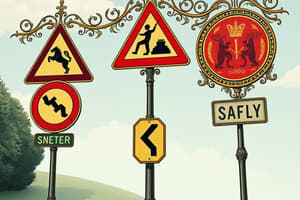Podcast
Questions and Answers
The ladybird is poisonous and uses bright colors as a warning.
The ladybird is poisonous and uses bright colors as a warning.
True (A)
The denied butterfly is poisonous.
The denied butterfly is poisonous.
False (B)
Mimicry in insects means harmless species can look like dangerous ones to avoid predators.
Mimicry in insects means harmless species can look like dangerous ones to avoid predators.
True (A)
The hoverfly is harmful and resembles the warning colors of bees and wasps.
The hoverfly is harmful and resembles the warning colors of bees and wasps.
Some animals use mimicry to camouflage and avoid detection.
Some animals use mimicry to camouflage and avoid detection.
Flashcards are hidden until you start studying
Study Notes
Warning Coloration
-
Some animals use bright colors to warn predators of their toxicity, like the ladybird with its red and black coloration.
-
Black and yellow are widely recognized as warning colors.
-
The African Queen butterfly is poisonous, and its bright coloration serves as a warning signal.
Mimicry
-
The Denier butterfly, although harmless, mimics the coloration of the poisonous African Queen butterfly to avoid predation.
-
The Denier butterfly's mimicry is an example of Batesian mimicry, where a harmless species mimics the appearance of a dangerous one.
-
Harmless hoverflies mimic the warning colors of bees and wasps to deter predators.
-
Some animals use mimicry to hide, like moths that resemble broken twigs, and mantises that blend in with leaves or flowers.
-
Some caterpillars mimic snakes to deter predators.
-
Butterflies can mimic dead leaves to blend in with their surroundings.
Warning Coloration
- Ladybirds use bright red coloration as a warning signal to predators, indicating they are poisonous.
- Black and yellow patterns are widely recognized as warning signals.
Mimicry
- The African Queen butterfly is poisonous, but the Denyed butterfly mimics its coloration despite being harmless.
- The Denyed butterfly's mimicry allows it to avoid predation by appearing poisonous.
- Mimicry is common among insects, with hoverflies mimicking the warning stripes of bees and wasps.
Camouflage
- Some animals use mimicry to blend in with their surroundings, like moths resembling broken twigs.
- Mantises can resemble leaves or flowers, providing camouflage.
- Caterpillars can mimic snakes, deterring predators.
- Butterflies can have wings resembling dead leaves.
Warning Coloration
- Some animals use bright colors to warn predators that they are poisonous.
- Ladybugs are poisonous and have bright red coloration as a warning signal.
- Black and yellow are common warning colors in nature.
Mimicry
- Some harmless animals mimic the warning coloration of poisonous animals to avoid predators.
- The African Queen butterfly is poisonous and has bright colors.
- The Viceroy butterfly is harmless and mimics the African Queen's coloration.
- The hoverfly mimics the warning stripes of bees and wasps to avoid being eaten.
Camouflage
- Some animals use mimicry to camouflage themselves and avoid predators.
- A certain moth resembles a broken twig.
- A specific mantis species closely matches the shape and colors of a leaf.
- Another mantis species resembles a flower.
- A particular caterpillar has evolved to look like a tiny snake.
- Some butterflies have wings that resemble dead leaves.
Studying That Suits You
Use AI to generate personalized quizzes and flashcards to suit your learning preferences.




